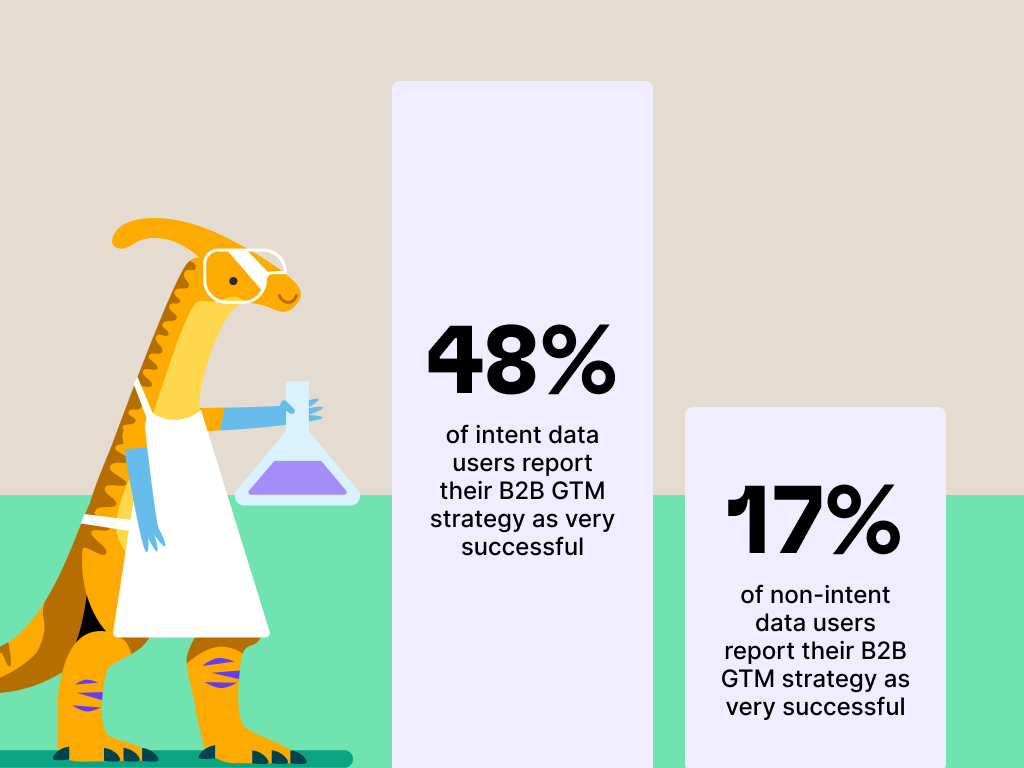Everyone’s got intent data, maybe your team is using Vector, Bombora, 6sense, Influ2, or other competitors. It’s the same playbook, just with a different dashboard.
In fact, in a survey of over 600 B2B GTM practitioners, 48% of intent-data users reported their GTM strategy as “very successful” compared with only 17% of non-users. (Intentsify)
And intent data is great, it shows you who might be ready to buy. Instead of spraying and praying with your messages, at least you are targeting folks that might be thinking about you. The problem is that it doesn't tell you what to do next.
That’s where network signals come in. They’re the only time of signal that leads to an actionable next step.

The Rise (and Plateau) of Intent Data
Before we had any data, marketing’s main goal was to blast out messages about products and services to as many people as possible. The problem is that when people are receiving unsolicited messages, they are far less likely to give a positive response.
When buyers moved to online shopping, sellers realized they were leaving breadcrumbs behind.
These breadcrumbs became what we know as intent data. It showed where someone was interacting with your brand, like clicking on your website. It solved a visibility problem that gave signals that someone might be in-market for your product.
Intent data worked wonders in the early 2010s when few teams used it. But today, buyers are hit with hundreds of “I saw you’re hiring” messages. A recent LinkedIn study found that 72% of buyers now ignore outreach that references surface-level intent signals because it feels impersonal.
The issue isn’t adoption, it’s differentiation. When every team has the same signals, intent data stops being a competitive advantage and starts being table stakes. The “Congrats on your funding round!” or a “I saw you’re hiring for X role…” messages are flooding inboxes, and the returns are diminishing.
You’re doing all this research and gathering these data points just to sound the exact same as everyone else.

From Insight to Action
Intent data shows interest signals. It shows what content your buyers are consuming and the topics they’re searching. But, these insights stop short of relationship context.
The missing step is activation, or turning data into connection.
Activation is the bridge between data and human connection, it’s how you move from “who’s interested” to “who can open the door.”
Despite widespread adoption, only 30% of B2B marketers use intent data across the full funnel (Zymplify). That means most of those insights never turn into actual conversations.
Intent data shows you who’s knocking, and network signals hand you the key.
For example, let’s say you see a target account researching the term “sales enablement.” Cool. Now what? Network signals show that your advisor’s former colleague works there.
That’s your path in.
Network signals identify overlaps across your company’s graph; employees, investors, advisors, and customers; and map them to your target accounts. Think of it as a live heatmap of your relationship capital. These paths aren’t theoretical; they’re introductions waiting to happen.
When paired with intent data, network signals turn awareness into opportunity. According to LinkedIn data, referred leads convert 4–5x higher than cold prospects (LinkedIn Business Blog).
Network signals are real-time insights into who in your extended network can get you into your target accounts. Unlike other signals, they come with a built-in action: Request the intro.
These signals also inherently reinforce trust. Intros convert 4-6x higher than cold outreach. When paired with intent data, sellers can prioritize warm accounts.
Here’s an example flow of combining intent data with network signals:
- BirdDog surfaces an account showing high intent.
- Commsor reveals a warm intro path to that same account.
- Seller requests the intro directly, no cold outreach required.
- CRM updates automatically to reflect the connection and relationship strength.
The next era of GTM isn’t about more signals, it’s about connected signals. We’re saturated with data and insights, we don’t need more of it. We need direction.
Network signals make each and every data point actionable. It’s human.
This is the foundation of the Go-to-Network movement; where sales is powered by relationships, not randomness.
Don’t stop using intent data, make it mean something.
Want to turn your intent data into intros? See how Commsor can help you activate your signals.














